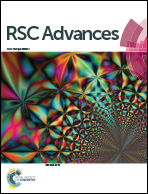A novel long-wavelength fluorescent probe for discrimination of different palladium species based on Pd-catalyzed reactions†
Abstract
We have synthesized a novel long-wavelength fluorescent probe MFC for detection of palladium (Pd0). This probe not only shows high selectivity for palladium, but also could quickly discriminate different palladium species (Pd0, Pd2+, Pd4+) in phosphate buffered solution. After the reaction with Pd(PPh3)4, the UV absorption of the probe MFC shifts from 334 nm to 594 nm within a few minutes. The probe MFC conjugated with alkyl carbamate, which destroys the principle of intramolecular charge transfer (ICT) and shows weak fluorescence. Based on the Pd0-catalyzed Tsuji–Trost deallylation reaction, the fluorogen was released and the fluorescence intensity at 612 nm was observed with 13-fold enhancement along with an obvious color change from yellow to purple with low detection limit.



 Please wait while we load your content...
Please wait while we load your content...